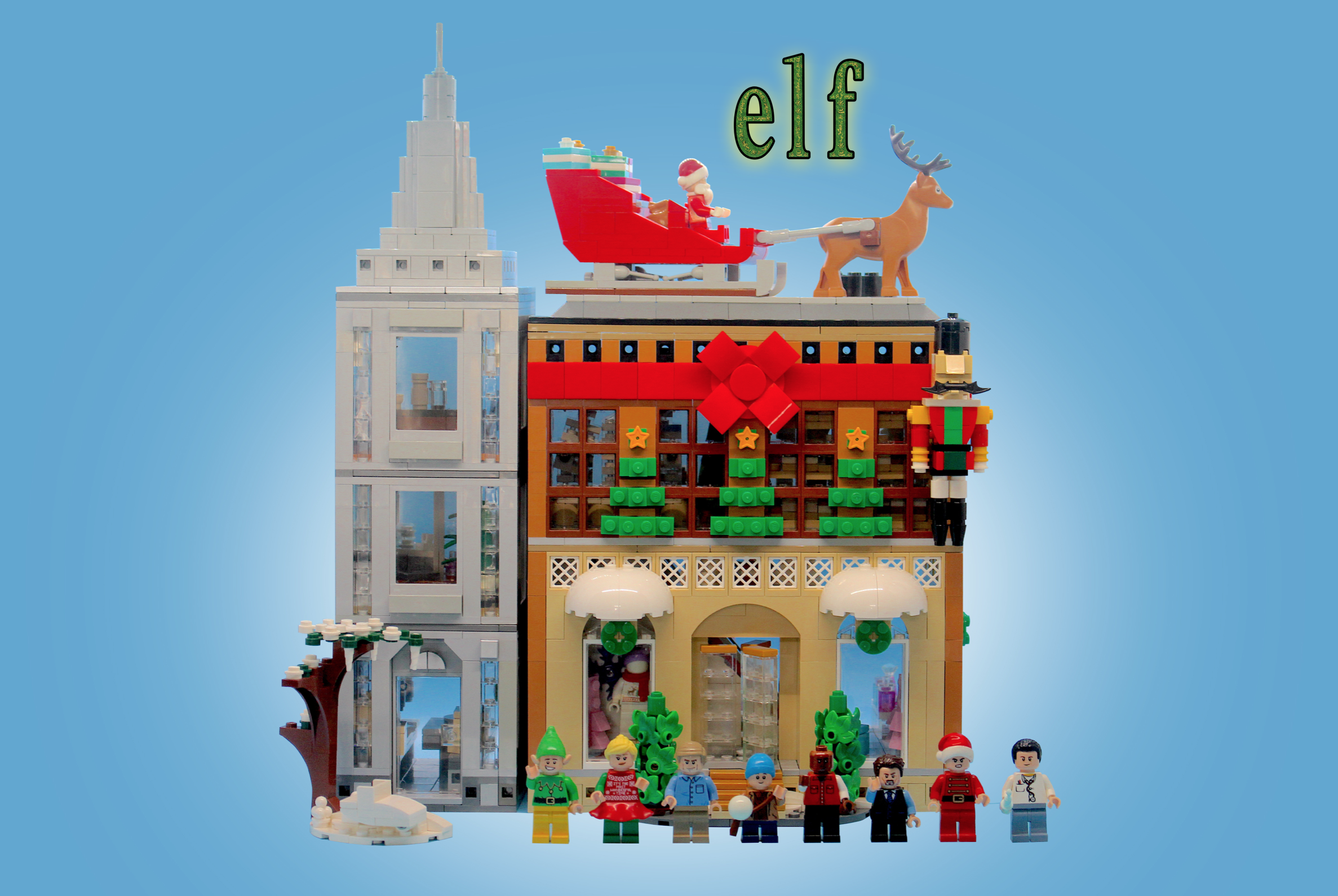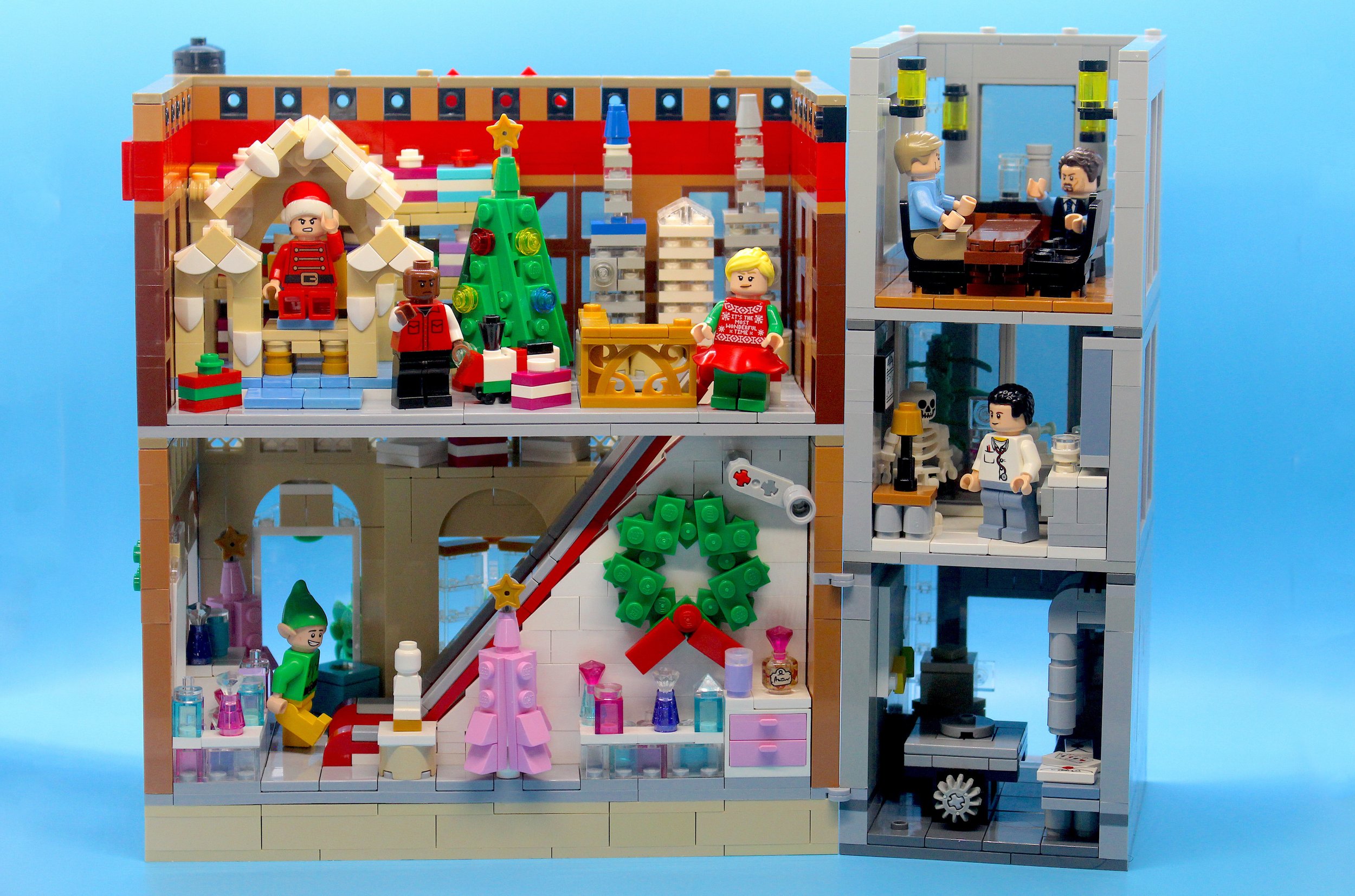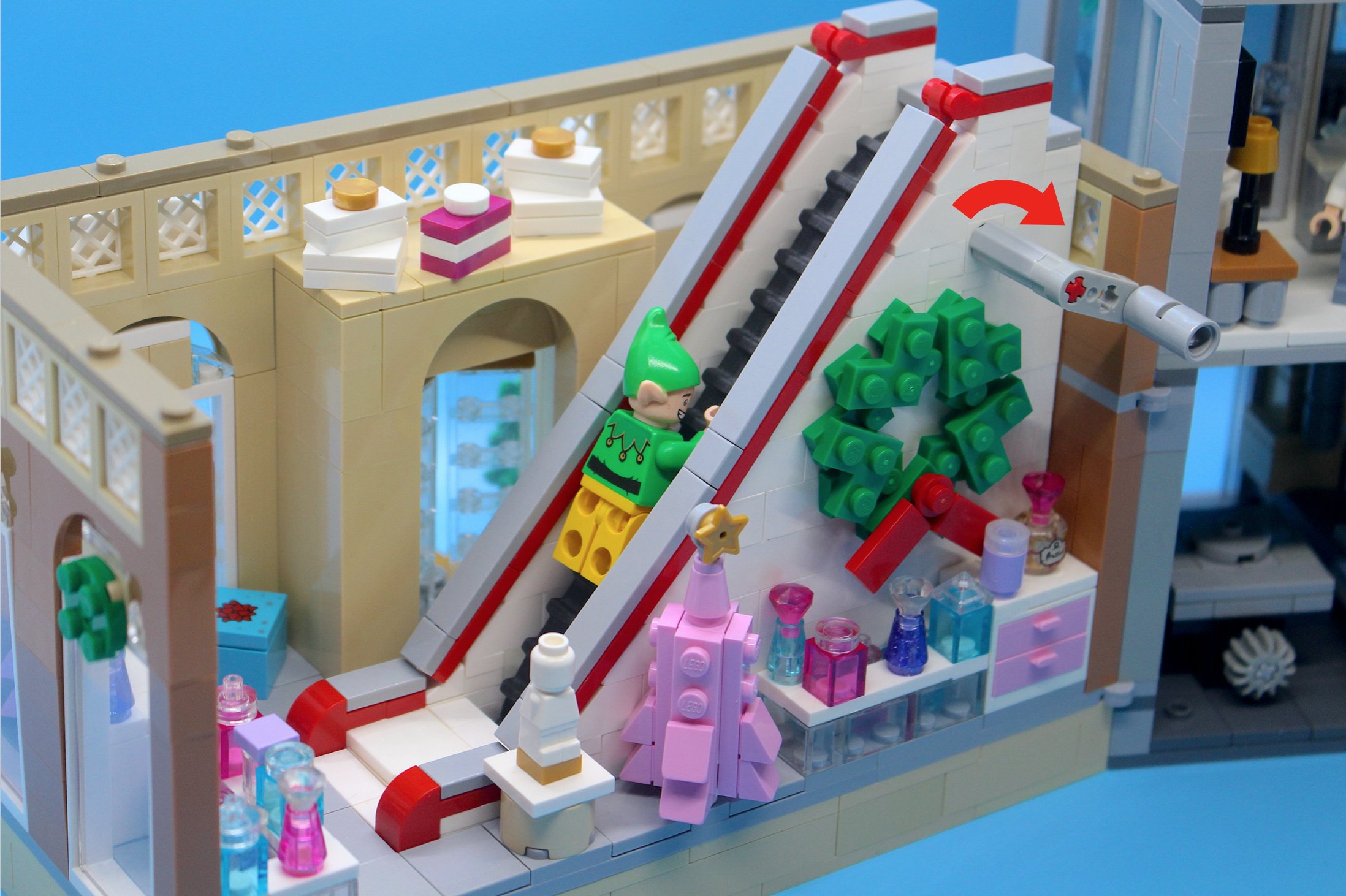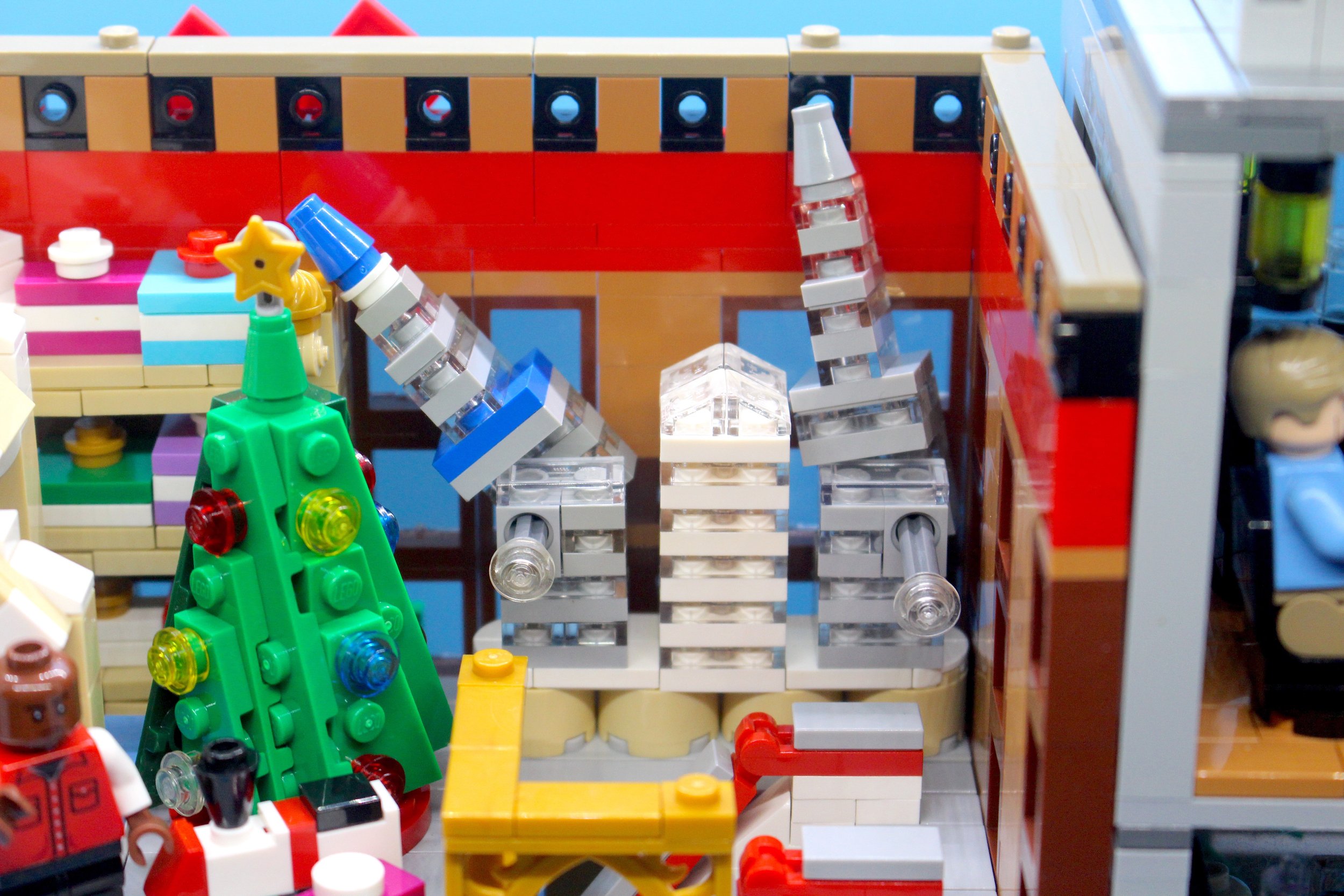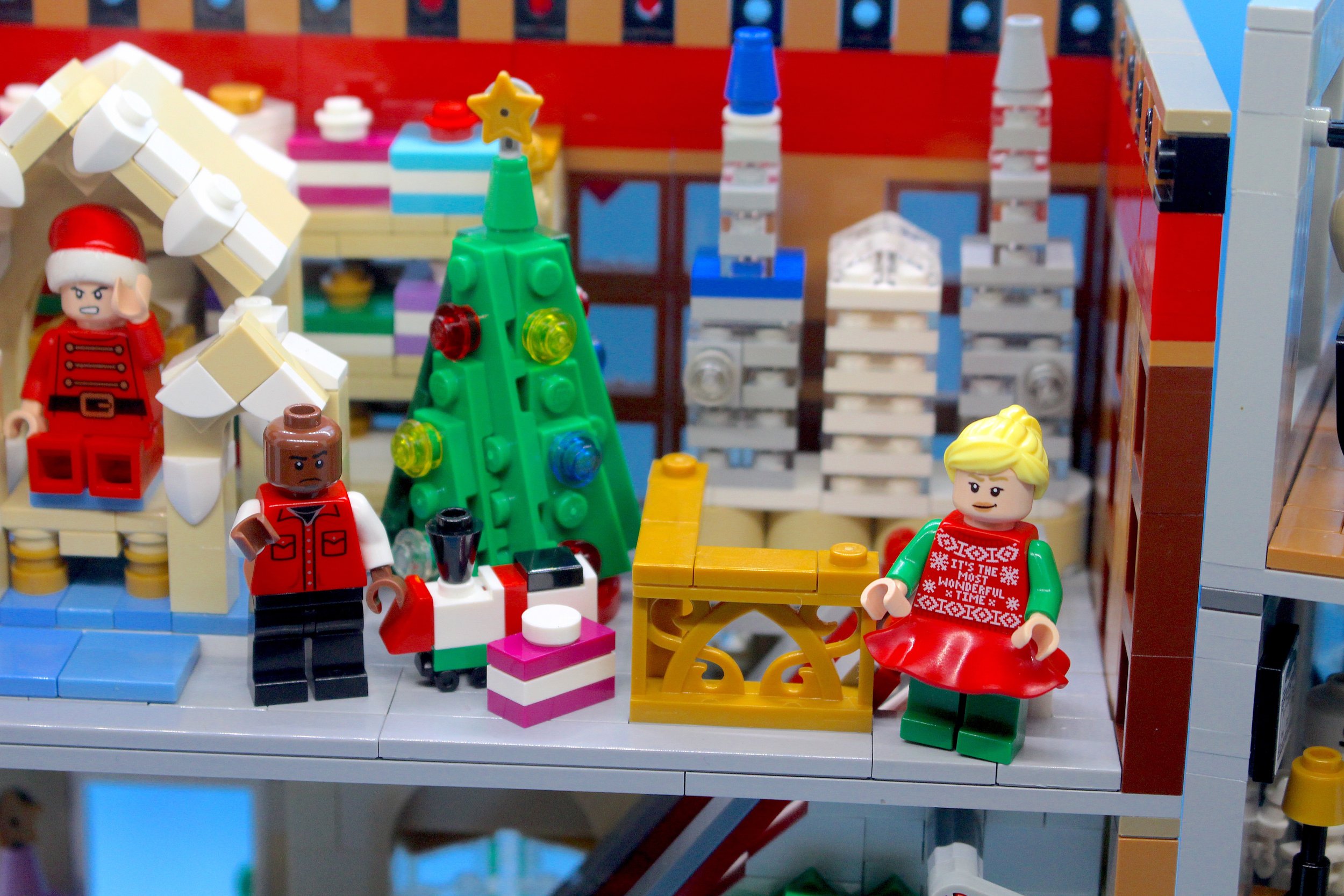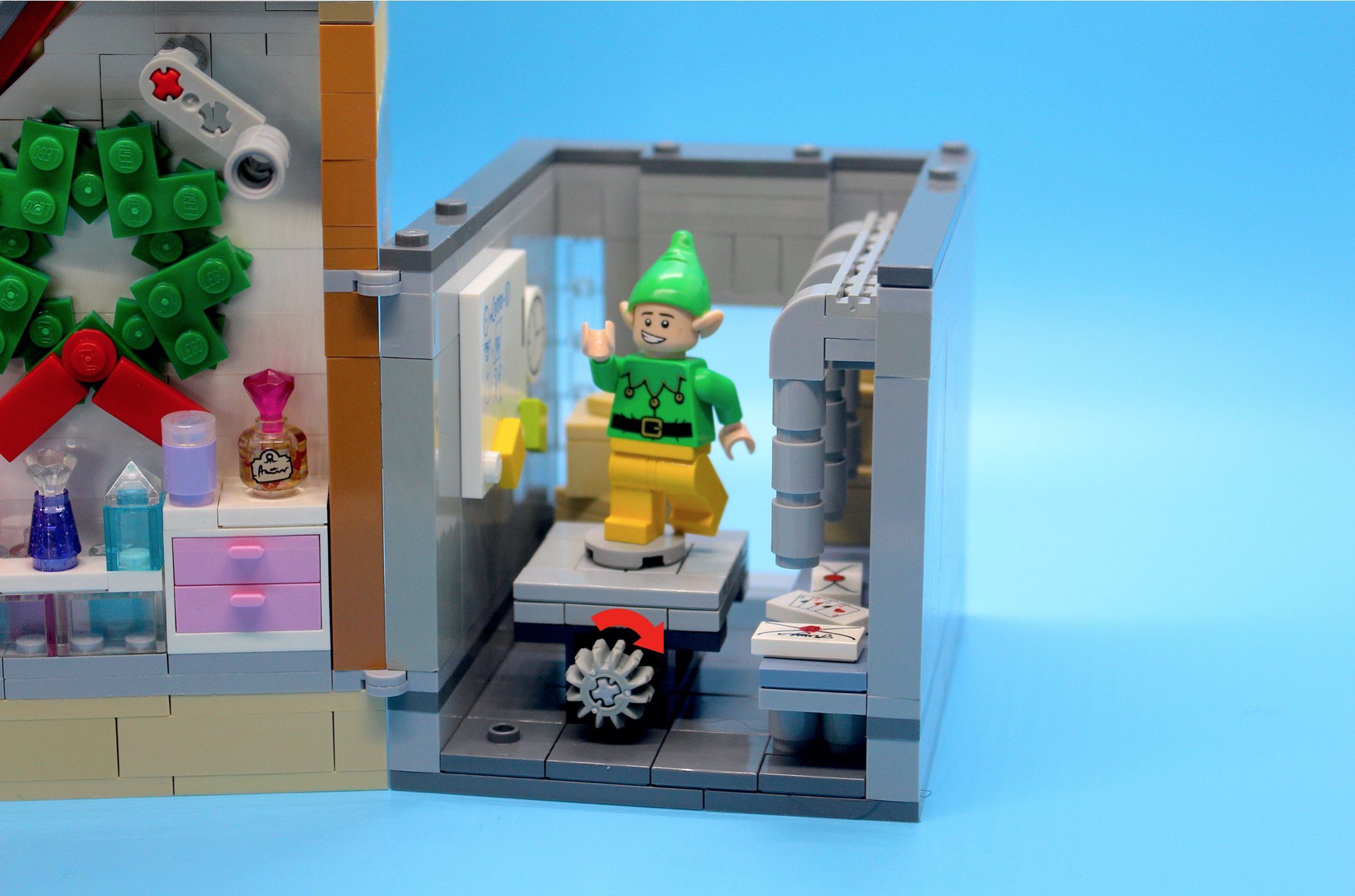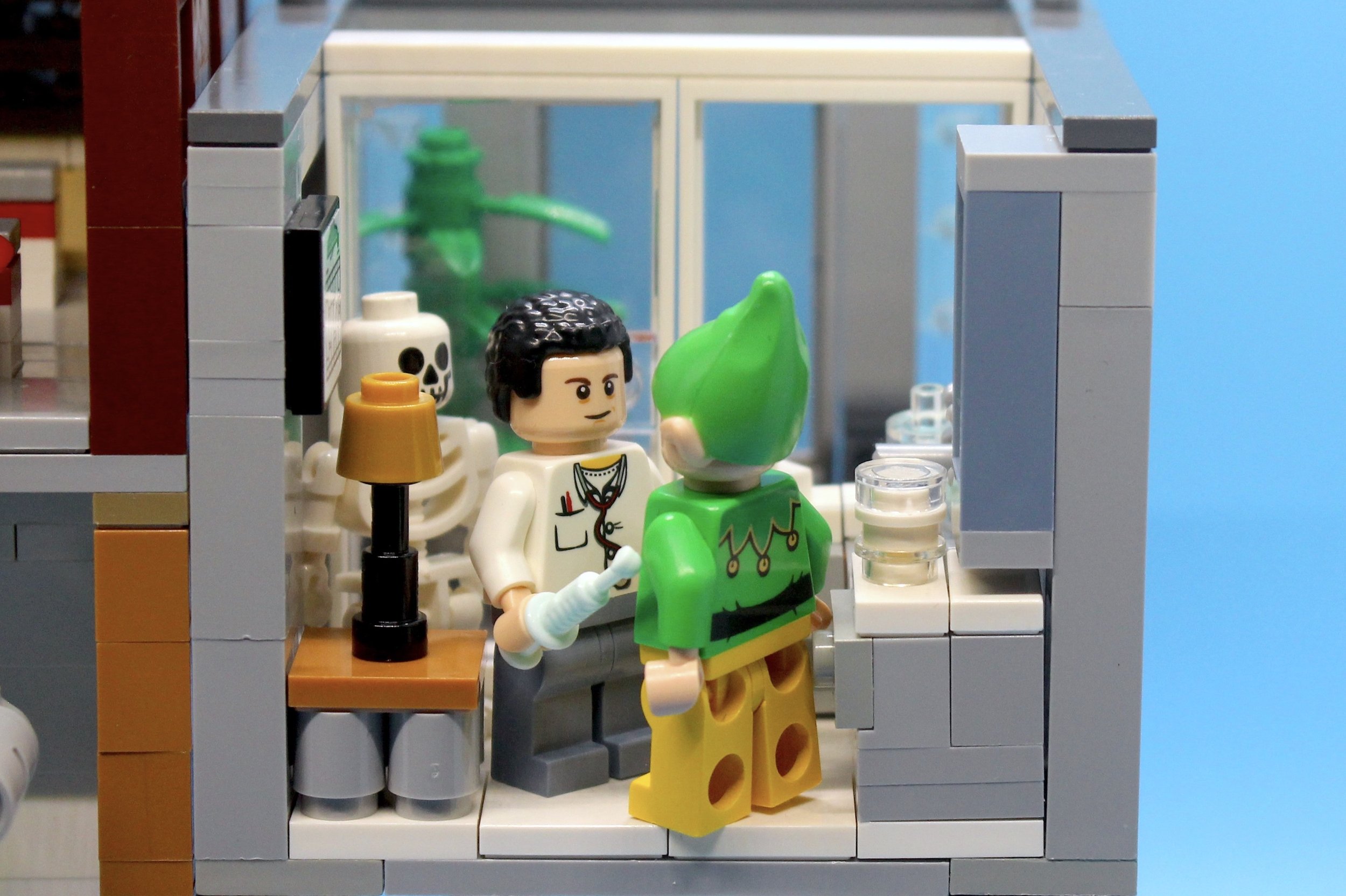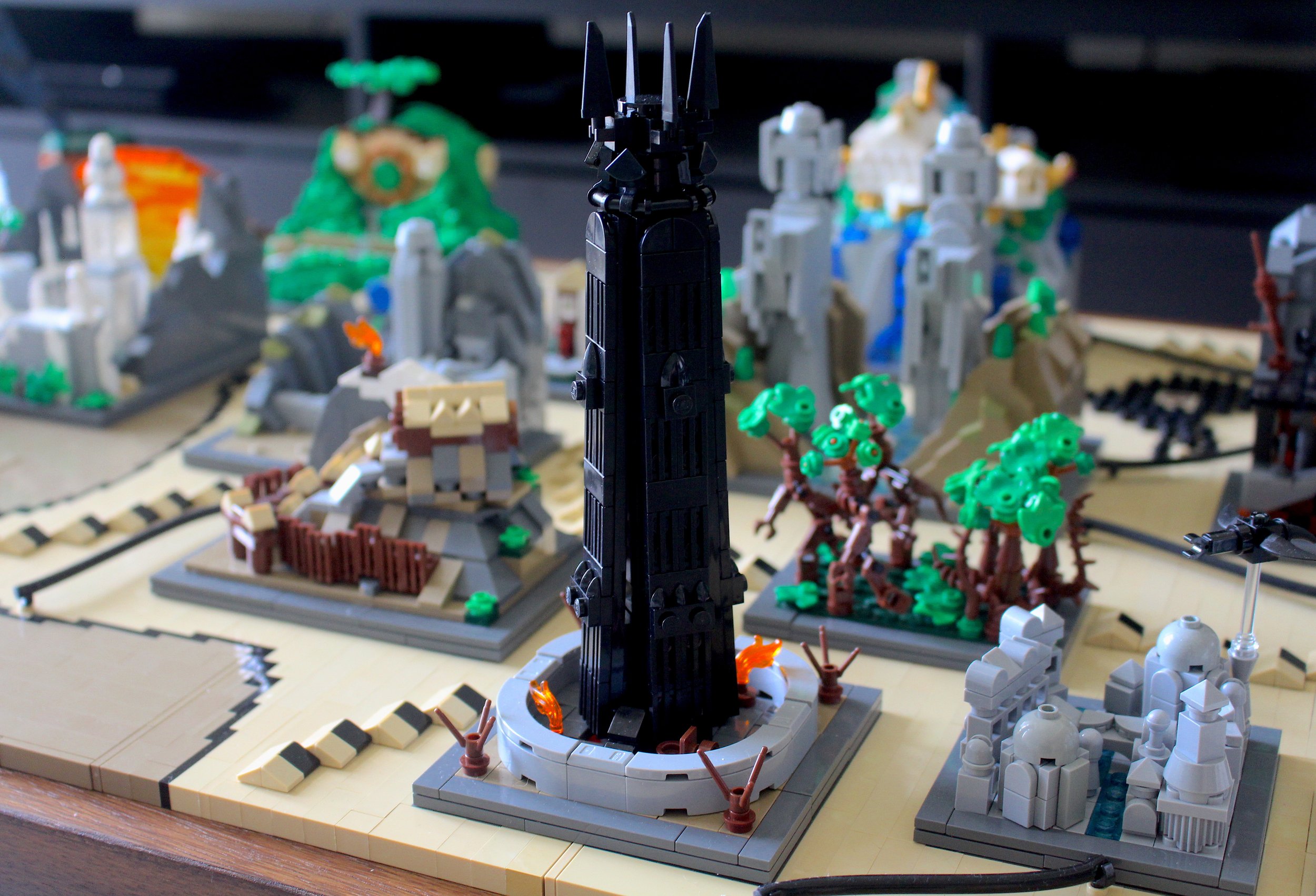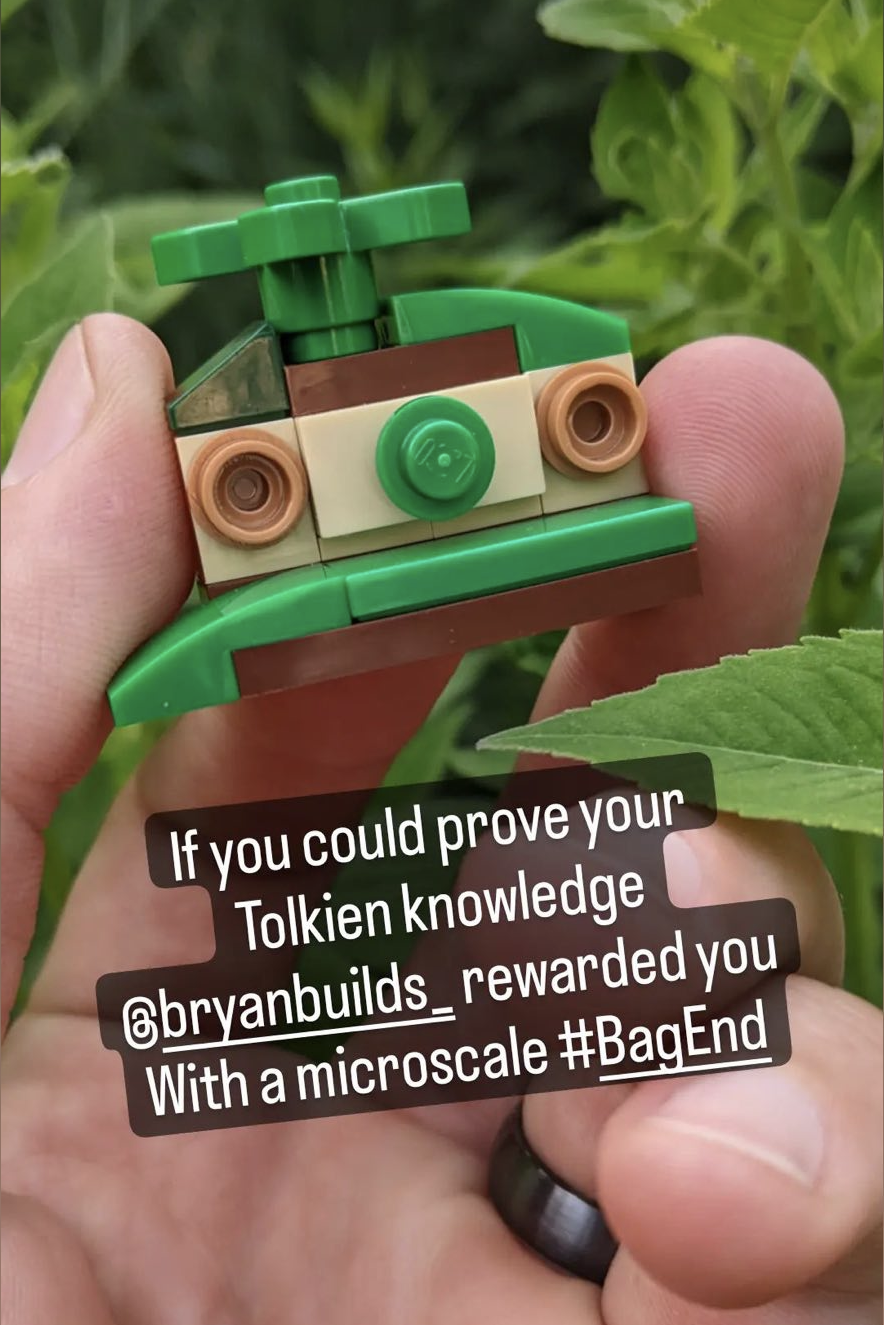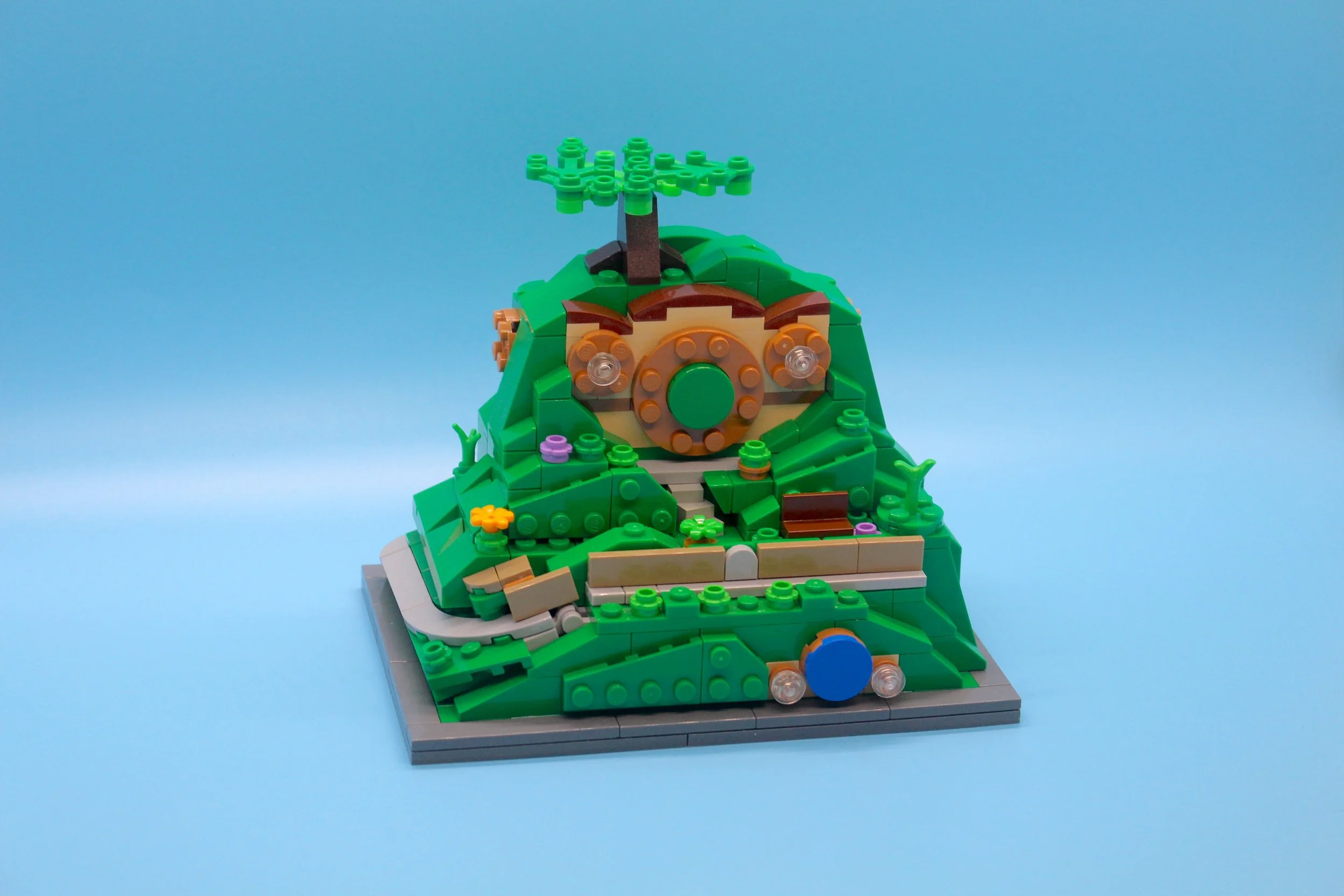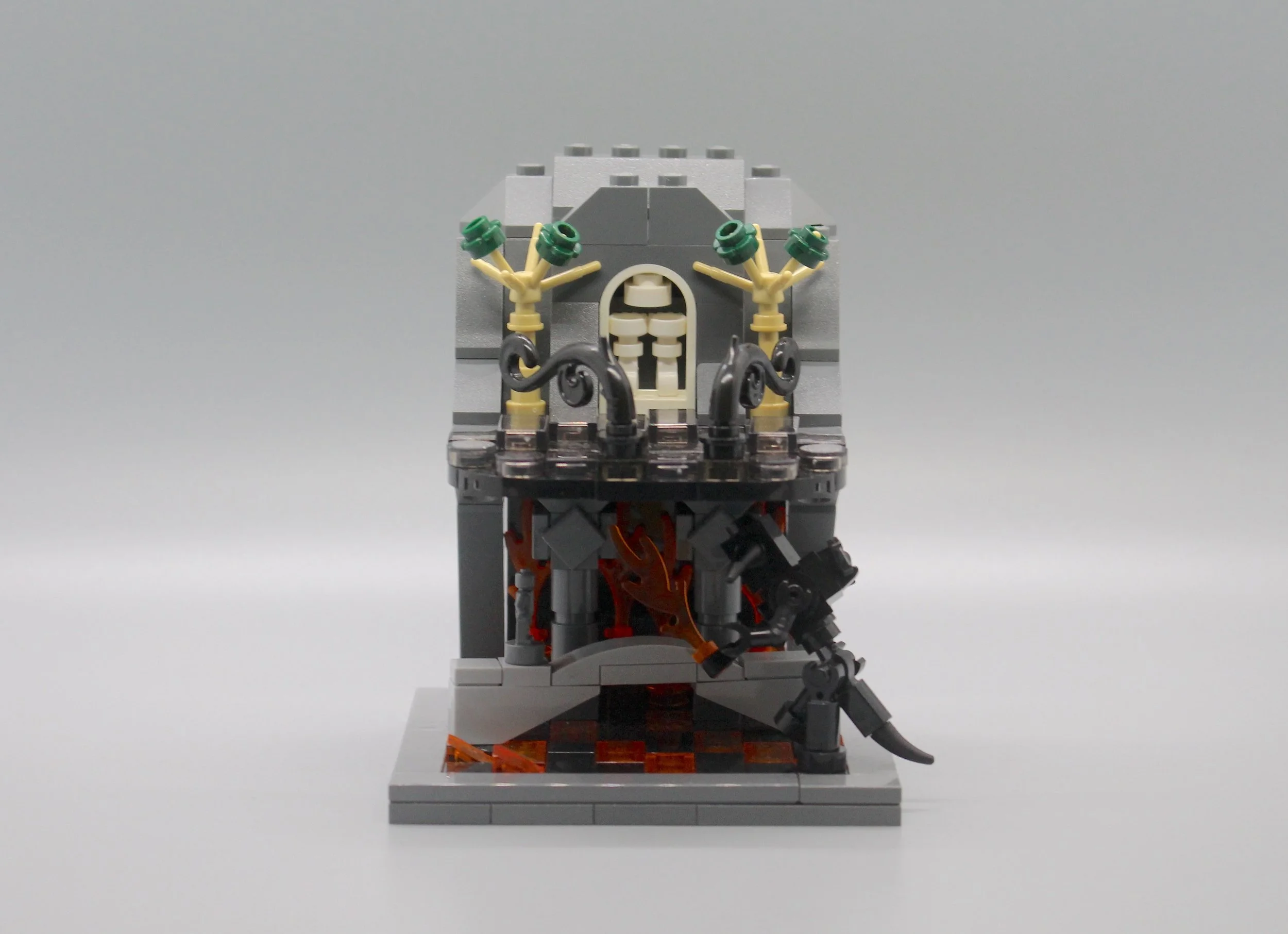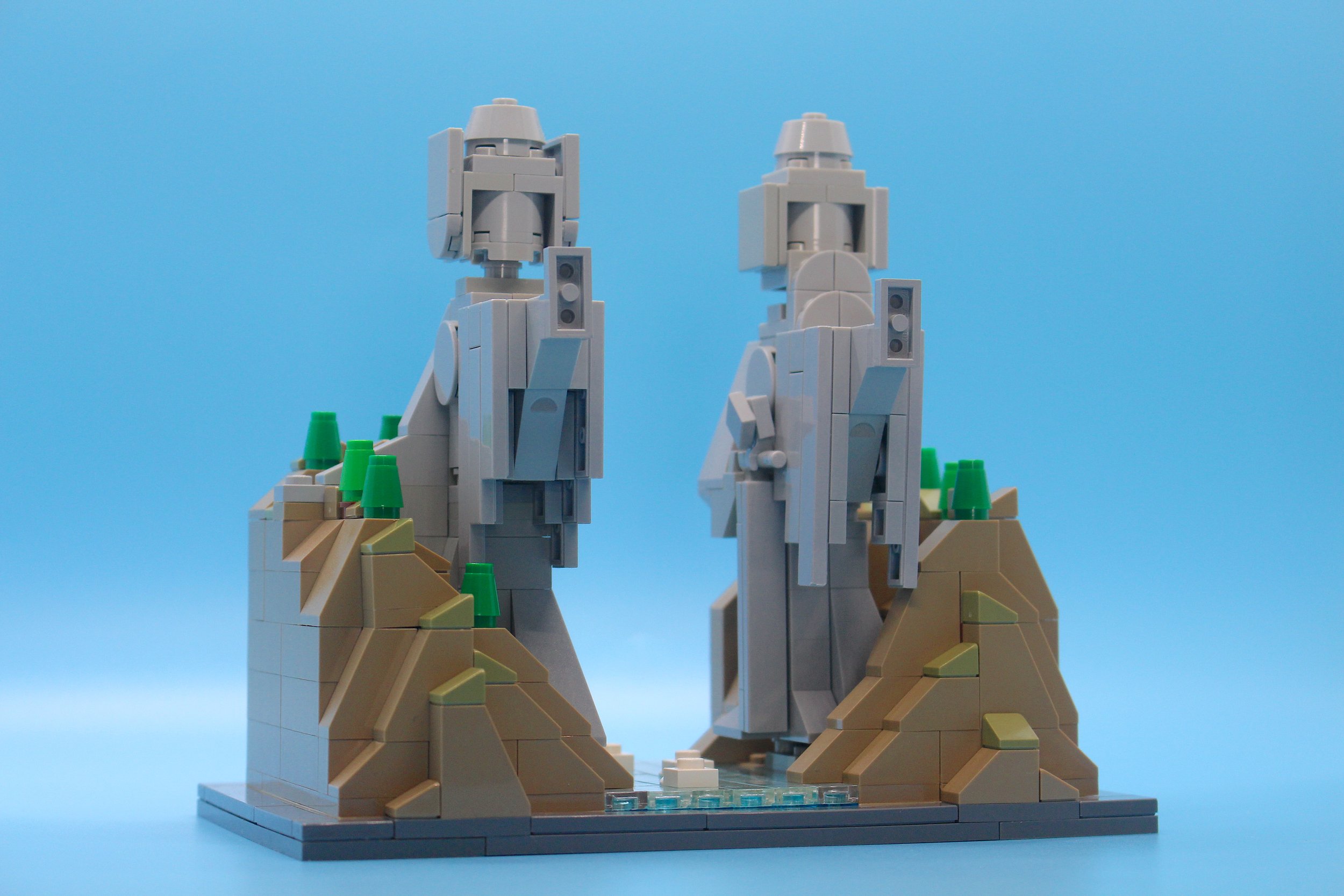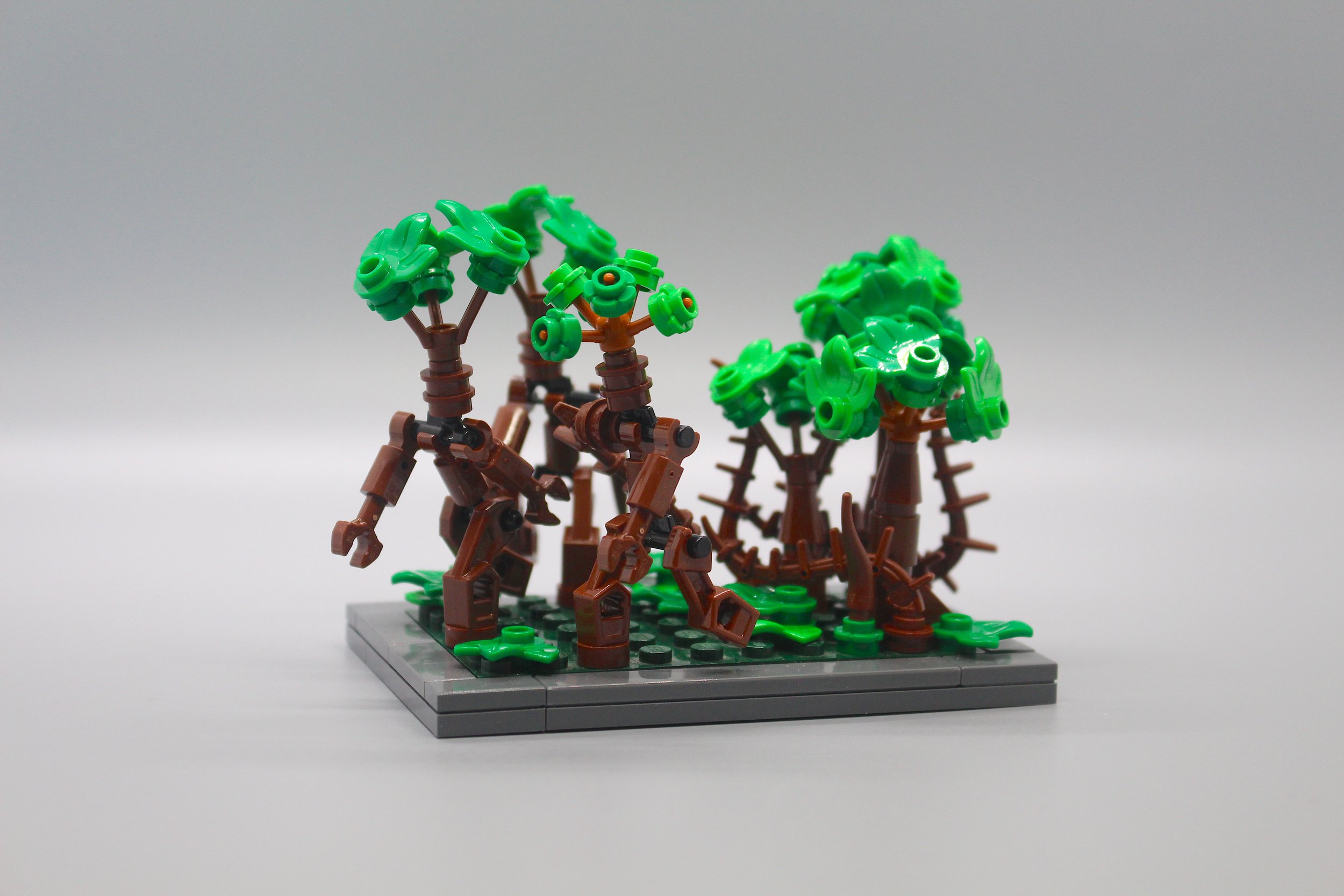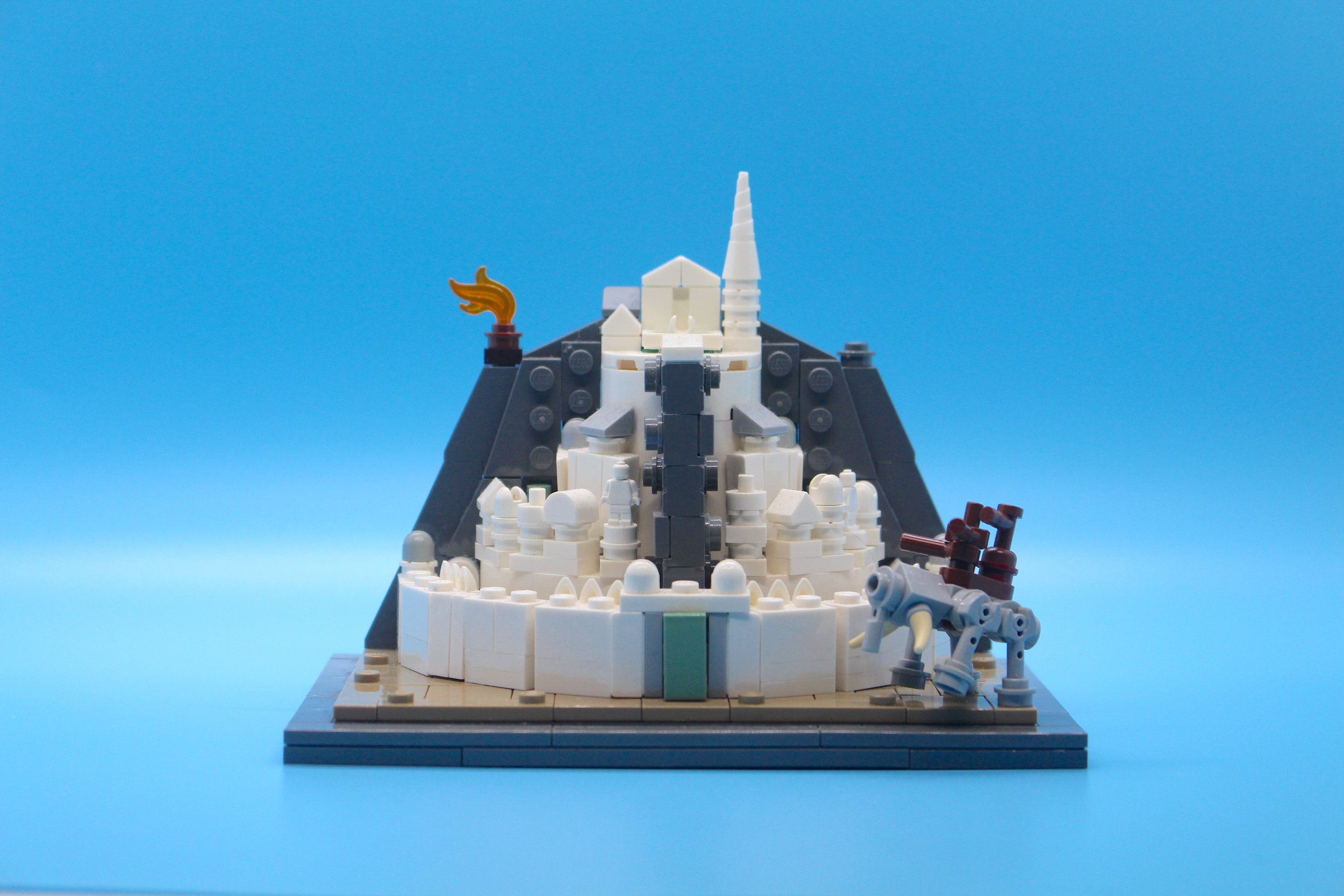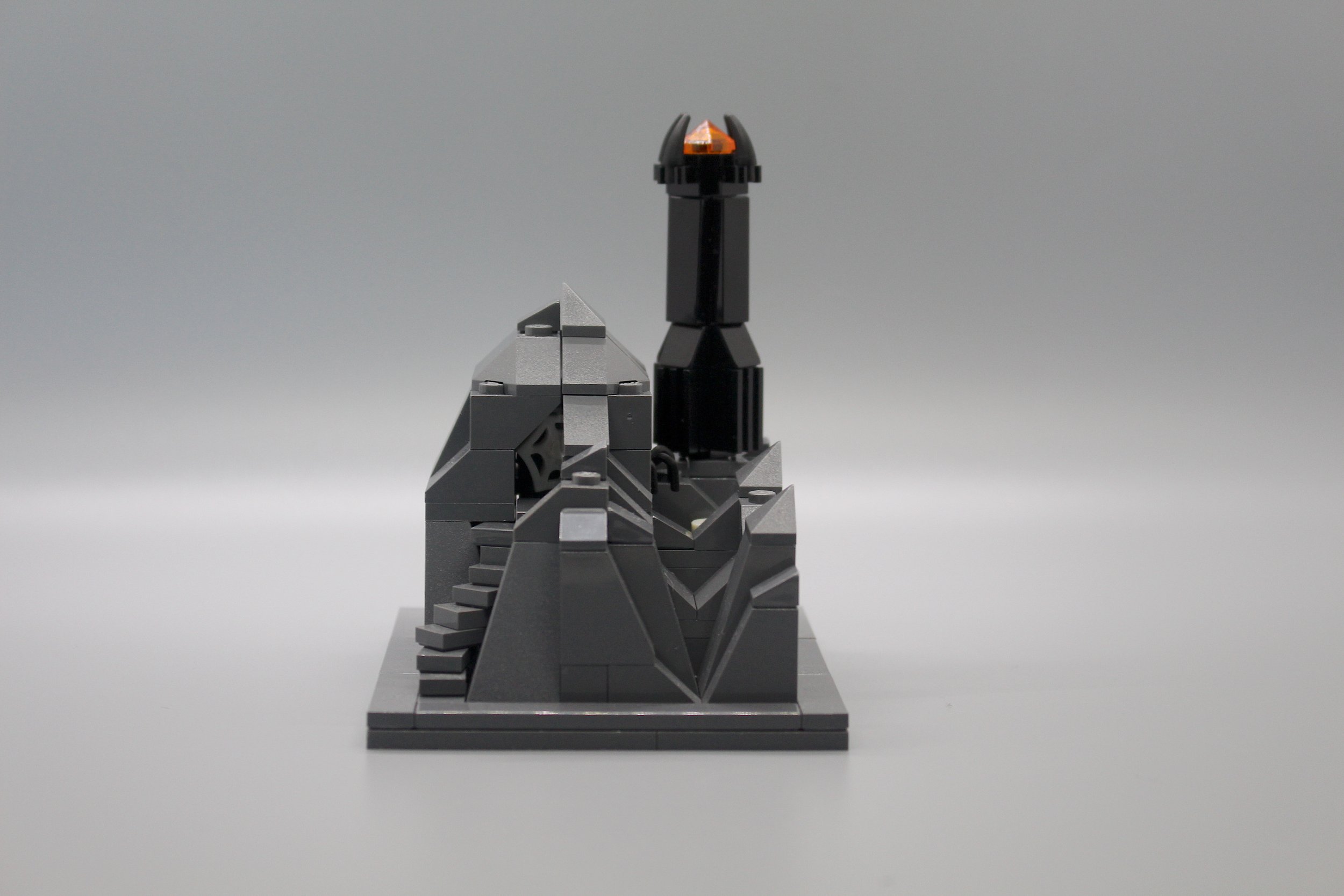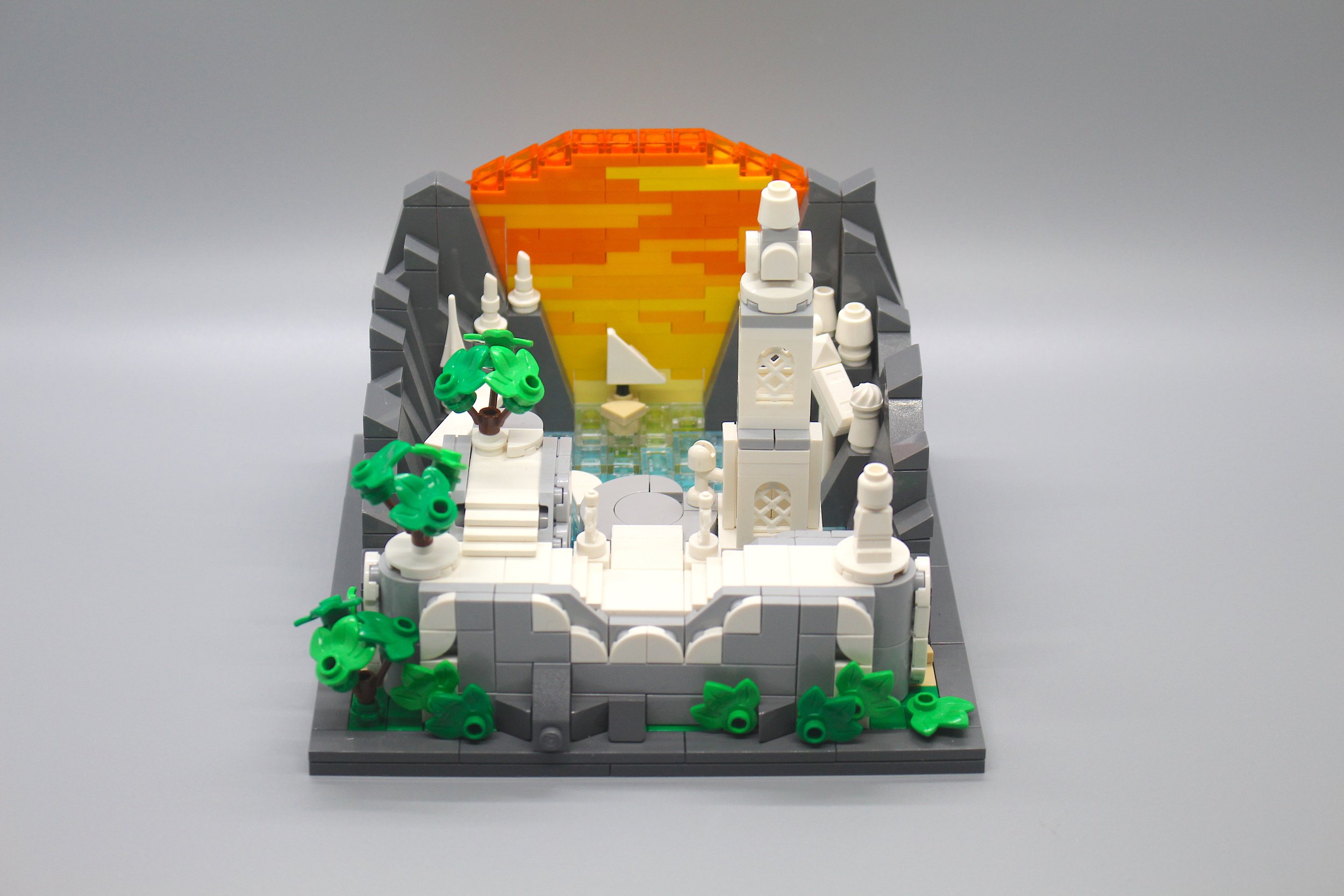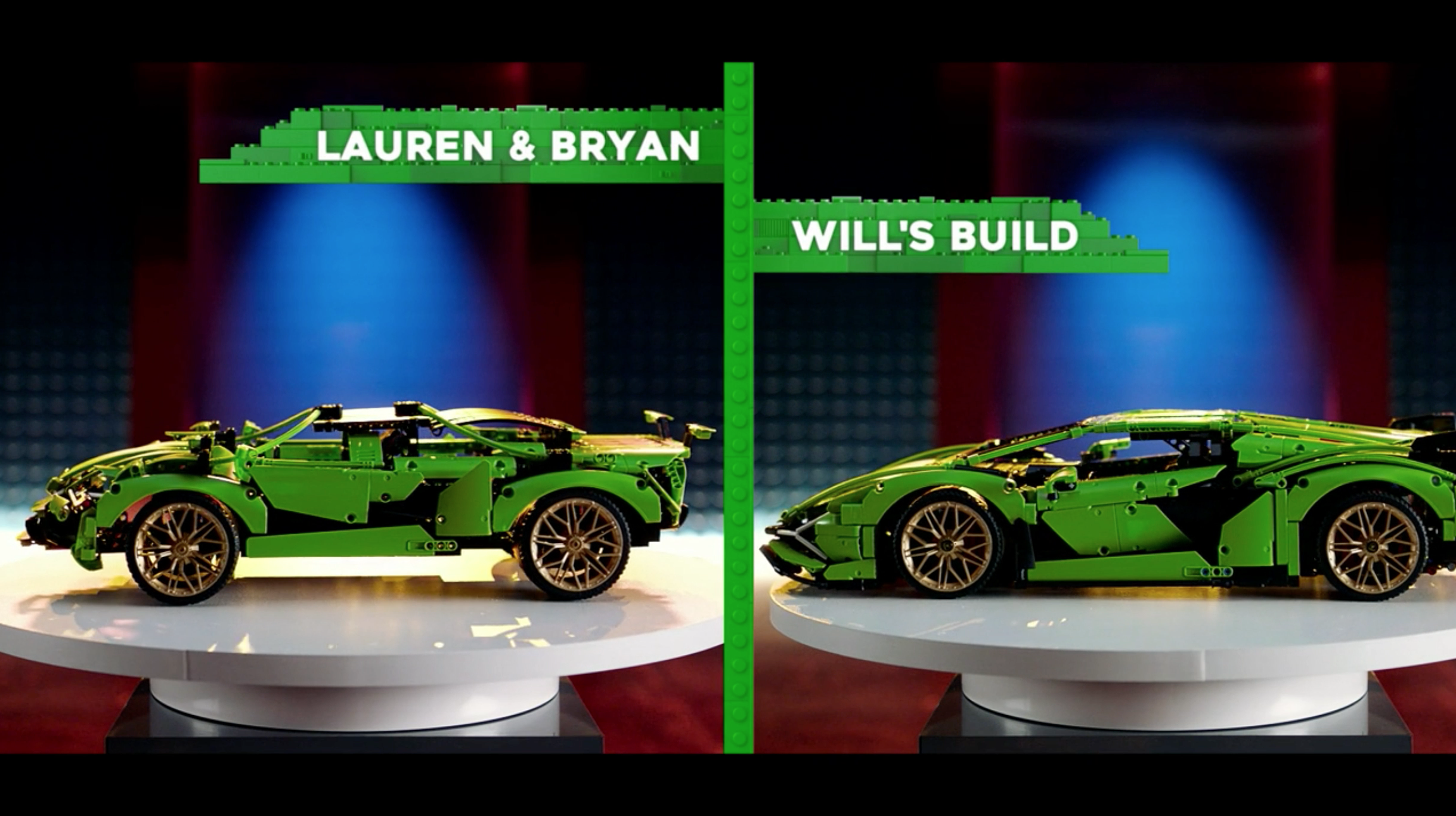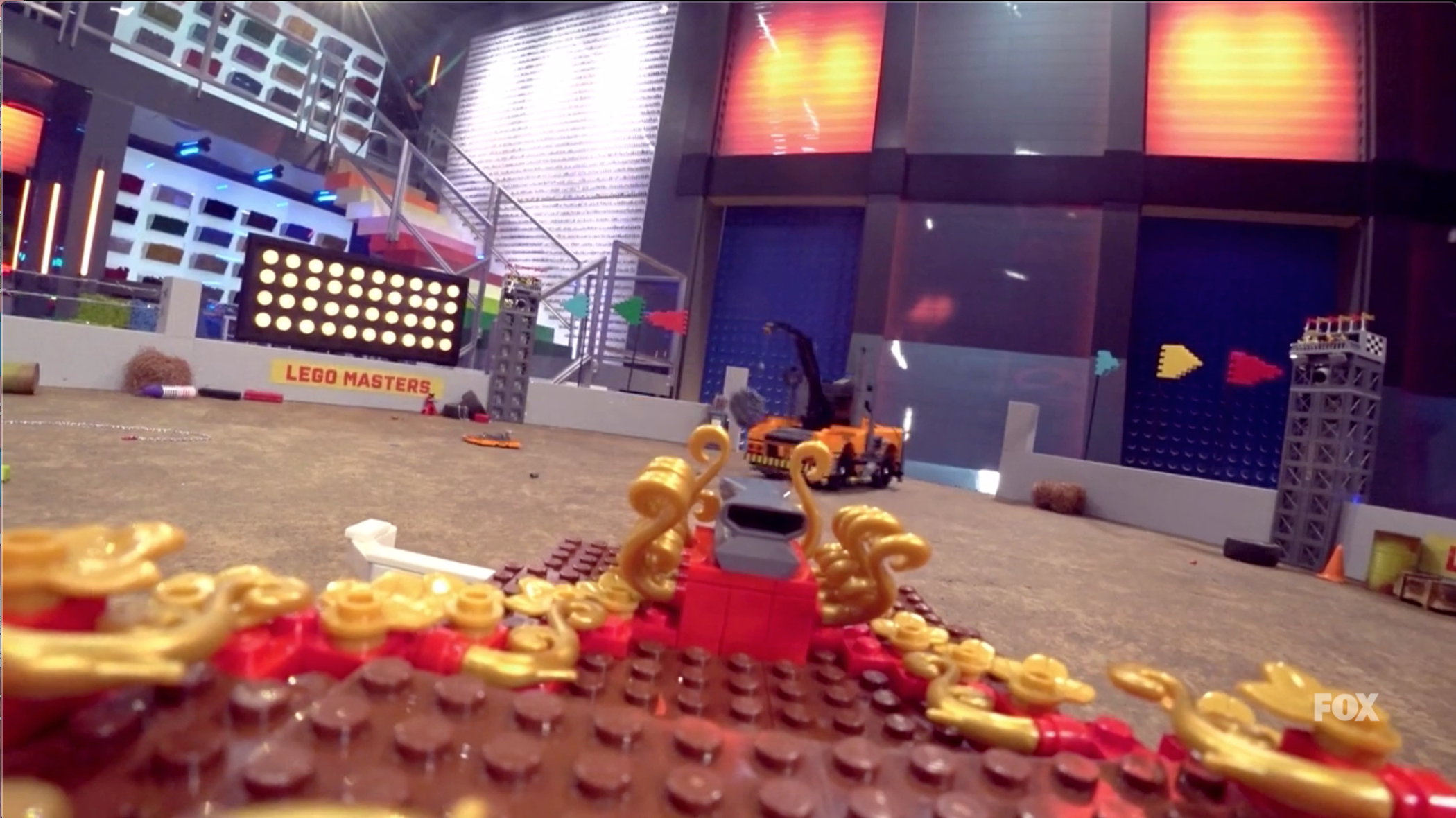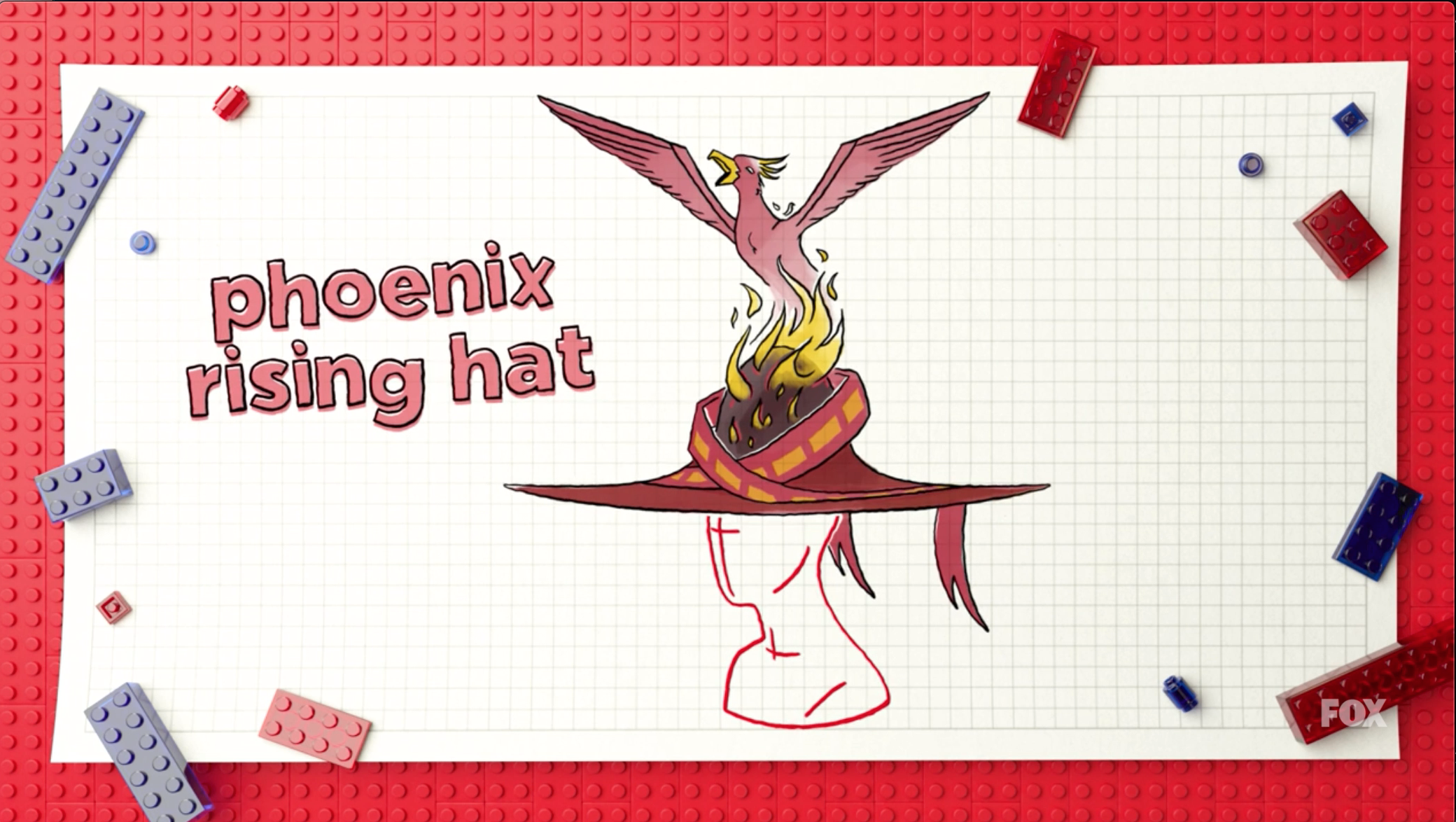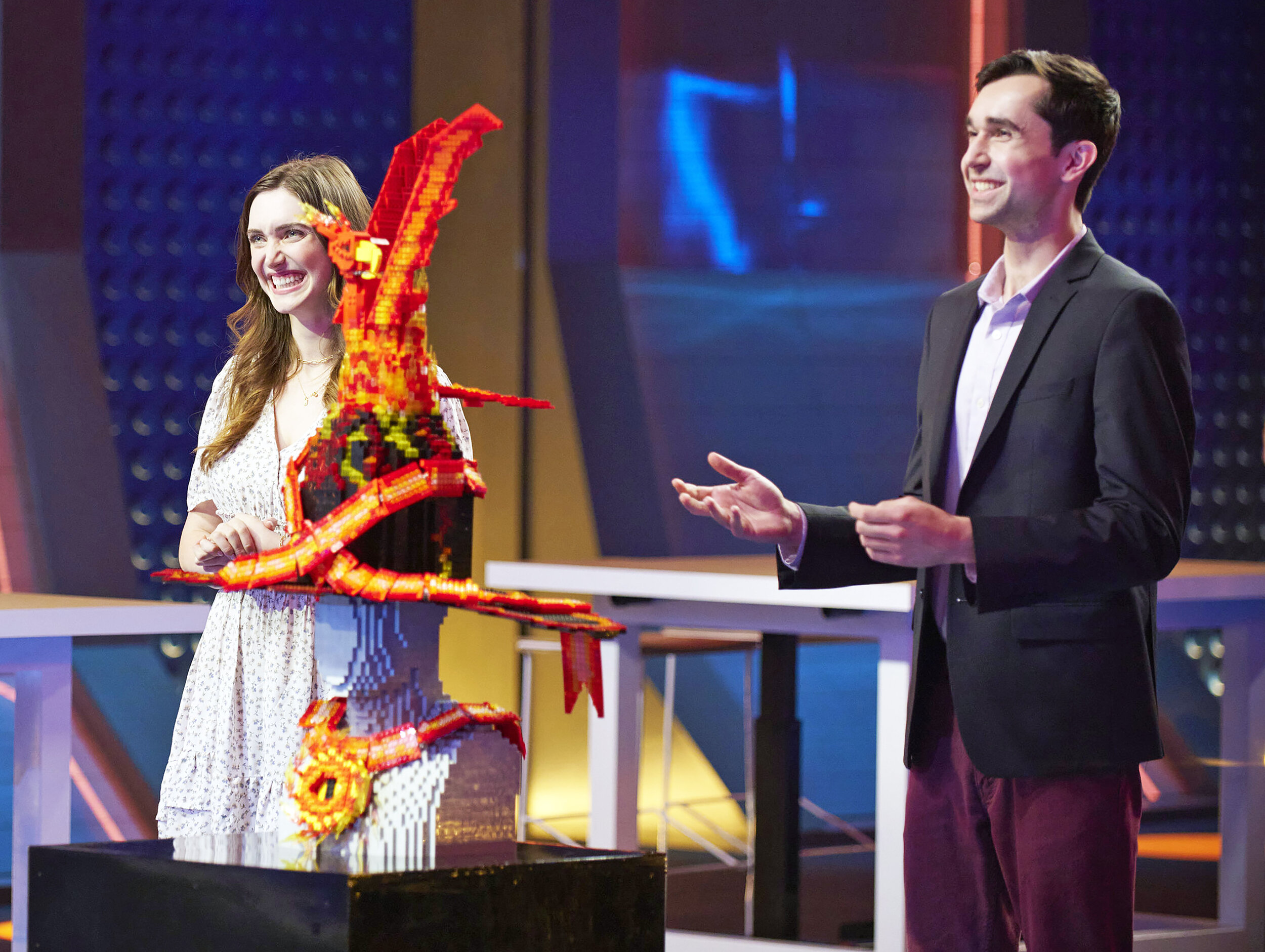In 2023, I designed my first-ever set for LEGO Ideas: ELF! Featuring a modular Gimbels Department Store, skyscraper, and nine minifigures, the set celebrates the 20th anniversary of the classic holiday movie.
1. DESIGNING THE INTERIOR
I knew from get-go that the build had to incorporate as many Elf-tastic movie moments as possible. Inspired by the “Home Alone” set that came out in 2021, I wanted to reflect these moments in a modular-style building chock-full of interior details. The Gimbels Department Store was an obvious first choice; but then I realized just as many famous movie moments happen in the Empire State Building! So I conceived the set as two separate structures, attached by hinges.
The interior construction of the department store all depended on the most essential part: the escalator that Buddy does the splits on! Creating a working escalator was one of the challenges I set for myself in the project. I ended up using a tire tread with large ridges, to resemble steps, and attached it to wheels on a crank shaft. The escalator can be cranked to move Buddy up and down (funny enough, it works the best when he’s sprawled out on the escalator just like in the movie).
Because the treads have to dip below the floor line, I needed to raise the floor of the department store by about two bricks. And since the escalator ascends through to the second floor, there had to be a gap in the floor of the second story. Buddy can seamlessly go up and down the escalator whenever he wants now!
While the bottom floor is dominated by the escalator, the top floor is filled with details and scenes from the movie. I had to include Santa’s throne, made by Buddy himself. Of course, it ends up being occupied by “Fake” Santa who chases Buddy around the store. My favorite scene was always when Fake Santa knocks down the skyscrapers of small plastic bricks (unclear if they’re LEGO, but they might be!) — so I had to include that here for some meta LEGO-within-LEGO action. The skyscrapers can tumble apart if you pull out the pins that keep them just barely together. If Fake Santa knocks them over with a bat, they’ll go flying!
I also added a Christmas tree in the top floor that Jovie can decorate, plus presents all around. There’s a massive shelf of presents in the back, behind the Santa throne. It’s easy to miss, but definitely would be enough to stock Santa’s sleigh.
The first floor of Gimbels includes makeup counters (where Buddy gets sprayed with perfume) and mannequins in the windows. One window has a present that Buddy can rest his head on if he wants to sleep there and get found by his father Walter in the morning.
In the Empire State Building, my favorite function is in the mail room on the first floor. It has a table with a spinning top where Buddy can dance for all the mail room employees. It also has little tubes for mail, plenty of letters, plus a clock and whiteboard.
The second story has the doctor’s office where Buddy gets a shot, and where Walter finds out he’s really his son. The doctor is there (played by the director Jon Favreau) and there’s a life-size skeleton as featured in the movie. This floor is split in two, with the back half being the waiting room where Buddy sits next to the small girl and eats a cotton ball (I made sure to include a little jar of cotton balls in the office).
Finally, in the top floor of the skyscraper is the conference room for Walter’s company, where famous children’s author Miles Finch gives advice on their new book. Miles doesn’t take too kindly to Buddy calling him an elf, and you can re-enact this scene on the long conference room table. A fun part of this section was the back desk, which was built using SNOT techniques and several sideways-facing plates to get the right color and texture.
2. DESIGNING THE EXTERIOR
The exterior had some unique challenges, namely the nutcracker balloon! It was difficult to build a small character out of bricks that could hang from a building AND resemble a cartoon form. Thanks to plenty of rounded elements for the arms and legs, it came together at a pretty good scale. My favorite touch is the Batarang for his mustache!
Because the buildings are modular, I wanted each floor to have its own defining features, especially for Gimbels. The bottom story has big white awnings using unique rounded elements, and snow-bound steps with gold tiles. The revolving door uses a tri-pronged Technic piece and translucent bricks; it was tricky to get the Technic axle coming up from the floor and be flush with the rest of the floor, so the door can spin! But I needed to have that scene of Buddy going round and round in the revolving door!
The top floor has plenty of windows to let in natural light, but also a massive bow wrapped around the building! The bow is one of my favorite constructions of the exterior, using a simple combination of curved tiles and rounded plates/tiles to create something I think looks quite a bit like the real thing.
Of course, the top of the building wouldn’t be complete without a Sleighpad for Santa. While it’s not a component of the movie, I knew I wanted a place for Santa to land because his sleigh felt like a must-have vehicle for the set. So I tiled off an “S” on the top, instead of an “H,” letting Santa know where to land. There’s also a chimney that Santa can pose in on top, though it doesn’t lead down into the building..!
Outside Gimbels, I built a little snow-frosted tree and grounds for Michael to play in. There’s a snowball catapult where Buddy can launch snowballs with Michael at rapid speed. Some ice cream cones are stacked in the background to look like Buddy’s piles on piles of snowballs.
Moving on to the Empire State Building, I wanted the exterior to evoke a towering skyscraper while still keeping the modular feel. I included just one large window on the front of each story, to let light in, and added lines of silver and translucent along the sides to create a sense of verticality. For the top, a relatively simple SNOT construction achieved the iconic Empire State look— sans King Kong! The top used to be taller, but I shortened it for a more balanced height differential between the two buildings.
I think the two buildings pair nicely together: the long and short department store, with the tall and skinny skyscraper. Gimbels has bright colors and warmer tones, offset by the Empire State’s sleek silvers. Santa’s Sleigh perched on top of Gimbels adds more height and color to that building, which I think is a great way to display the set. Gimbels has two stories, while the Empire State has three, and each has a removable roof. Each layer is attached by a few studs, just like the LEGO modular sets (which I referenced while building this!)
3. DESIGNING THE MINIFIGURES
I knew the minifigs would be an essential part of this set, and that I had to design them entirely using existing LEGO bricks! While some sacrifices had to be made, overall I am happy with how they came out. Buddy is achieved using holiday elf garb that was already available, plus a LEGO Friends elf hat. I would love it if there was an element with the hair too (and without the ears), that would be perfect! His big smiley face is the same face I use for my sig fig.
Jovie has a custom Christmas sweater on, and a (expensive!) red skirt. I would love to see her with an elf hat on too, but there wasn’t an element with the right look. Maybe if the set gets made one day, that could happen! I also had a lot of fun with the Miles Finch minifig using Aragorn’s stern bearded face. A fun crossover between fantasy actors, with Peter Dinklage of course being the star of Game of Thrones! Fake Santa was also fun — I used Draco Malfoy’s face (I had forgotten that Fake Santa is decidedly clean-shaven) and a nutcracker torso to make him just off from the actual Santa torso.
I think the Doctor also came out well, using Sheldon from Big Bang Theory’s head and the right curly hair piece for Jon Favreau. Walter was an especially tricky one with the elements available, but I think the chiseled jaw face from an old Spiderman set did the trick. The hair could be a bit curlier/thinner, but none of the potential elements came in the right color.
All the minifigures in the set (9) are as follows: Buddy the Elf, Jovie, Walter, Michael, “Fake” Santa, Gimbels Manager, Dr. Leonardo, Santa Claus, Miles Finch.
4. PLAY FEATURES
Many of the play features have been discussed already, but I wanted to put them all in one place (just like I used to pore over in LEGO Magazines as a kid!)
Take Buddy up the fully-functioning escalator
Dance in the mailroom with the spinning table function
Catapult snowballs with Michael outside
Make miniature "LEGO" skyscrapers tumble apart
Land Santa’s sleigh on the Sleighpad on the roof.
Spin through the revolving doors of the department store
